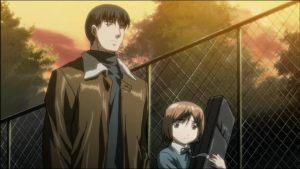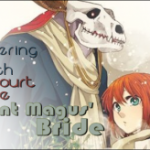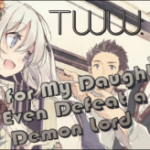The Wandering Witch Reminisces with Gunslinger Girl

Welcome, all, again. As regular readers will know, I tend to gravitate towards slice-of-life series. However, I might seem to some to be a bit generous with that designation, including series that obviously belong to other genres. My own position is that most living things–works of art included–have multiple facets to their being, thus enabling me to focus upon some aspect others might overlook. Gunslinger Girl, our subject show today, seems to me quite similar to past subject KanColle in that each set of girls must establish their own normalcy while their function as instruments of death necessitate their segregation from regular society. And in the case of both shows, while concurrently absorbed and unsettled by the sequences showing the girls in combat, it was actually the down time between assignments that really drew me in as a viewer. Quiet, shared moments such as doing laundry or sharing snacks. The hushed, urgent gossip. The petty arguments that pale against the desperate support provided and accepted in the face of limited lives always colored by imminent death. Have no doubt that these young shinigami are both conflicted and terrified.

Gunslinger Girl had two seasons as an anime, each with its own distinct story arc. The premise is terrifying in its implications: the Italian government sponsors a charitable organization called the Social Welfare Agency (SWA), funding rehabilitation for children who have suffered life-threatening injuries. At least, this is the public line. In actuality, certain young girls helped by the Agency are selected to receive cybernetic implants and trained to become government assassins. Those chosen are completely removed from contact with their families (assuming those families still live) and tend to regain consciousness from their life-threatening conditions with their bodies already modified and their memories thoroughly wiped. Each girl is then given into the care and training of an older male handler who is called her fratello (brother); typically, this handler has prior police and/or military experience which he incorporates into his charge’s training. Assigned to Section 2 of Special Ops, the Agency’s counter-terrorism division, these girls become expendable, deniable soldiers who specialize in the assassination of the Italian government’s enemies or–in certain cases–its own more unruly members.

Season 1 (2003-4), while introducing viewers to a full cast of girls and handlers, is very much the story of Henrietta and her fratello Giuse (also called Jose). Giuse is deeply troubled by the government’s use of children as killers, and does his best to treat his charge Henrietta as a true little sister–just one whom he trains for and occasionally sends into combat. But even he must admit that her new identity might be preferable to her remembering her former life–Henrietta was the sole survivor of her family’s massacre, and it seems that she was only spared for purposes of entertainment, being repeatedly raped by her family’s killers. When Giuse first sees her, she is laid out in a hospital, where the staff tell him that she is suicidal (when conscious). And while she awakens without much in the way of personal memories, there is a lingering melancholy to the new identity she adopts along with her new name of Henrietta (chosen for her by Giuse). His sympathetic nature feeds into Henrietta’s reinvented personality, permitting them a closeness not often seen between the girls and their handlers. In fact, many colleagues consider them a weak team, emotionally unfit for some of Section 2’s darker missions. However, a number of the teams have ongoing issues: Angelica, the Agency’s first cyborg, begins to physiologically reject her modifications; Claes becomes emotionally unfit for duty after her handler Rabalo is killed; Elsa’s unrequited love for her handler Lauro leads to a possible murder/suicide. Thus season 1 sees the handlers wrestling with ethical issues while the girls confront more emotional issues.

Season 2 (2008)–titled Il Teatrino–is Triela’s story (much as season 1 was Henrietta’s), following her through an extended mission against a child assassin of the Padania Republic Faction (PRF), the terrorist organization SWA most often combats. Older than the other girls when she was cybernetically transformed, Triela acts as a big sister figure and mentor. She is unique in that her handler was also her rescuer before her transformation: Hilshire (an alias) found her severely injured on the set of a snuff film and brought her to the SWA for treatment, initially unaware of the agency’s predation on young girls. Theirs is thus an understandably complicated and often turbulent relationship. Honestly, this second season just isn’t as well executed as the first, despite a more focused storyline that moreover finally offers viewers some PRF perspective.
This show–particularly the first season–packs a devastating emotional punch. In fact, season 1 was the first complete TV series I ever bought for home entertainment; it really is just that good.
















iStalk? uStalk!